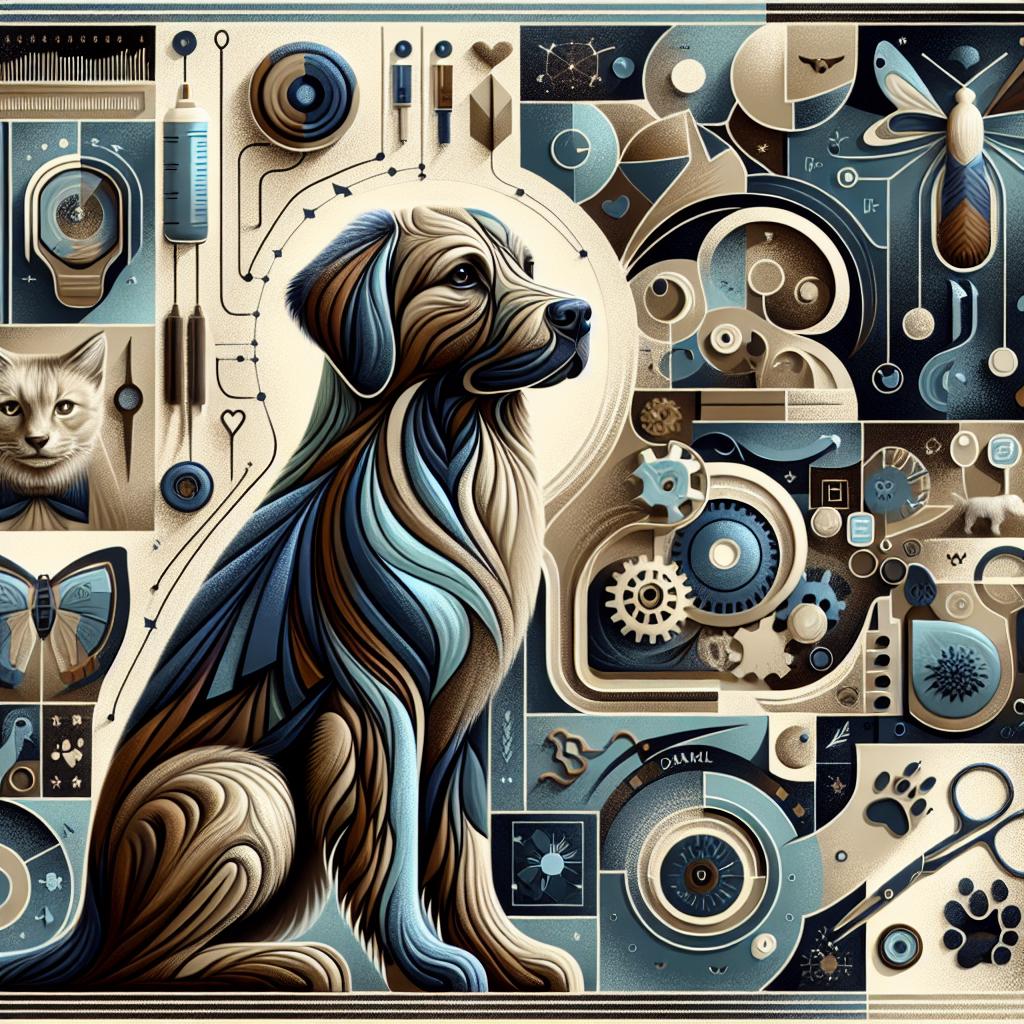Grooming your dog is more than just a routine task; it’s an opportunity for bonding, care, and connection. Yet, for many pet owners, the thought of grooming can evoke feelings of dread, especially when their furry friends resist the process. Tail-wagging excitement can quickly transform into anxious squirming, turning what should be a pleasant experience into a battle of wills. But fear not! With patience and the right techniques, you can teach your dog to embrace grooming sessions with calmness and poise. In this article, we’ll explore effective strategies and tips to help your pup feel relaxed and comfortable during grooming, making it a positive experience for both of you. Whether you’re dealing with a high-energy pup or a timid soul, read on to discover ways to transform grooming into a tranquil and enjoyable routine.
Understanding Your Dogs Stress Triggers During Grooming
Every dog has unique stress triggers, which can manifest during grooming sessions. Being attuned to these signals is essential for a calm experience. Some common stressors can include loud noises, unfamiliar scents, or even the sensation of water. Paying attention to your dog’s body language is crucial; look for signs such as whining, cowering, or attempts to escape. Understanding these triggers allows you to tailor your grooming approach, creating a more relaxed environment for your furry friend.
To effectively manage stress during grooming, consider implementing strategies that minimize these triggers. Here are some suggestions to create a soothing atmosphere:
- Desensitization: Gradually introduce your dog to grooming tools to help them feel comfortable.
- Calm Environment: Use soothing music and dim lighting to alleviate anxiety.
- Positive Reinforcement: Reward your dog with treats and praise to create positive associations with grooming.
Additionally, it may be helpful to note specific triggers affecting your dog in a table format:
| Trigger | Response |
|---|---|
| Loud Noises | Shaking, Ears Back |
| Water | Trying to Escape |
| Strange Tools | Growling, Licking Lips |

Creating a Positive Grooming Environment for Your Dog
Creating a nurturing atmosphere during grooming sessions is essential for reducing your dog’s anxiety and reinforcing positive behavior. Start by selecting a grooming space that is well-lit, quiet, and free from distractions. Use soft bedding or a non-slip mat to provide comfort, as this will help your dog feel secure. Ensure that all grooming tools are easily accessible yet out of your pet’s sight until needed, as this can further minimize stress. Consider the following elements to enhance the environment:
- Soothing Music: Play soft music or calming nature sounds to help create a peaceful ambiance.
- Positive Reinforcement: Keep treats on hand to reward your pet for staying calm and cooperative throughout the grooming process.
- Routine and Familiarity: Establish a regular grooming schedule so your dog knows what to expect and can become accustomed to the process.
Additionally, the grooming area should be set up in a way that allows for plenty of interaction and reassurance. Sit close to your dog and gently speak to them, offering comfort and encouragement as needed. Having another person present can also be beneficial, allowing for gentle distractions and additional calming presence. Incorporate these strategies into your grooming routine, and you may find your fur friend becomes more relaxed and even begins to look forward to their grooming sessions. Here’s a quick reference table for behaviors to encourage:
| Behavior | Action |
|---|---|
| Calm Sitting | Reward with treats and praise |
| Allowing Touch | Use gentle strokes and soothing words |
| Steady Breathing | Match your breathing to encourage relaxation |

Effective Techniques to Teach Relaxation and Patience
Teaching your dog to remain calm during grooming sessions is essential for both their comfort and your peace of mind. One of the most effective techniques is to introduce gradual desensitization. Start by familiarizing your dog with the grooming tools without immediately using them, allowing them to explore the brushes, clippers, and nail trimmers at their own pace. Pair this exploration with positive reinforcement, offering treats or praise to create a positive association. For example, let your dog sniff the brush and reward them for calm behavior before gradually increasing interaction by gently brushing their fur for short periods.
Another crucial strategy is the implementation of deep breathing techniques. Dogs are sensitive to their owner’s energy, so maintaining a calm demeanor can have a significant impact on their relaxation. Practice slow, deep breathing while grooming your dog. You can also give verbal cues, such as “easy” or “stay,” to encourage a sense of composure. Incorporate a routine with scheduled breaks during grooming sessions to prevent overwhelming your dog. This routine can develop into a predictable pattern that your dog learns to associate with calmness and patience.
| Technique | Description |
|---|---|
| Gradual Desensitization | Familiarize your dog with grooming tools before use. |
| Positive Reinforcement | Reward calm behavior with treats or praise. |
| Deep Breathing | Model calmness through controlled breathing. |
| Scheduled Breaks | Provide breaks to prevent overwhelming your dog. |

Building a Routine: Regular Grooming for Ongoing Calmness
Establishing a consistent grooming schedule not only enhances your dog’s appearance but also fosters a sense of security and routine in their daily life. Regular grooming sessions allow your pup to become accustomed to the sensations and sounds associated with the grooming process. This familiarity can help reduce anxiety and stress over time. Here are a few tips to ensure that these sessions are calming for your furry friend:
- Select a Comfortable Environment: Choose a quiet, well-lit space where your dog feels safe.
- Use High-Quality Grooming Tools: Invest in tools that are gentle on your pup’s skin and coat to make the experience enjoyable.
- Incorporate Short, Positive Sessions: Start with brief grooming sessions and gradually increase the duration as your dog becomes more comfortable.
Incorporating calming techniques will further enhance your dog’s grooming experience. Consider using soft music or white noise to create a soothing atmosphere while you groom. Additionally, simple rewards like treats or praise can reinforce positive behavior and encourage your dog to embrace grooming time. The following table summarizes some effective calming techniques:
| Technique | Description |
|---|---|
| Massage | Gently massage your dog while grooming to ease tension. |
| Calming Products | Utilize sprays or collars designed to reduce anxiety. |
| Scent Association | Use calming scents like lavender to create a tranquil space. |
Q&A
Q&A: Teaching Your Dog to Stay Calm During Grooming
Q1: Why is it important for my dog to stay calm during grooming?
A1: Keeping your dog calm during grooming is essential for their safety and comfort. A relaxed dog is less likely to fidget or resist, which can make the grooming process smoother and help prevent accidents. Additionally, a positive grooming experience can build your dog’s trust in you and the grooming process itself, leading to less stress in the future.
Q2: What are some common signs of anxiety in dogs during grooming?
A2: Dogs may show signs of anxiety in various ways. Common indicators include panting, whining, stiff body posture, attempting to escape, or even aggressive behavior like growling or snapping. Understanding these signs is key to addressing their needs and helping them feel more comfortable.
Q3: How can I prepare my dog for a grooming session?
A3: Preparation is key! Start by creating a calm environment. Introduce your dog to grooming tools slowly and let them sniff and explore them. Use treats and praise to associate grooming with positive experiences. Additionally, practice short grooming sessions to get your dog accustomed to the process over time.
Q4: Are there specific techniques to help my dog stay calm during grooming?
A4: Yes, several techniques can help! Try to use a soothing voice, play calming music, or have a favorite toy handy. Gradually desensitize your dog to grooming by starting with brief, gentle strokes and gradually increasing the duration. Employ positive reinforcement methods with treats and praise to reinforce calm behavior.
Q5: What if my dog doesn’t respond well to grooming?
A5: If your dog remains anxious despite your efforts, it may be helpful to consult with a professional groomer or a dog trainer specialized in behavior. They can offer tailored strategies to meet your dog’s needs. In some cases, a gentle calming aid or product designed for anxious dogs may also be beneficial, but always consult with your vet first.
Q6: How can I make grooming a regular and enjoyable routine for my dog?
A6: Consistency is vital! Incorporate grooming into your daily routine. Make it a fun bonding activity by mixing in play and treats. Observe your dog’s reactions and adjust your approach as needed. The goal is to create a familiarity and comfort around grooming, so it becomes a welcomed activity rather than a dreaded chore.
Q7: Are there any products you recommend for calming anxious dogs during grooming?
A7: There are several products designed to help soothe anxious dogs. Consider using calming sprays, anxiety wraps, or pheromone diffusers. Additionally, grooming tools specifically designed to reduce stress, like gentle brushes or quiet clippers, can be beneficial. Again, consulting your veterinarian is wise to find the best fit for your dog’s specific needs.
Q8: How can I ensure my dog associates grooming with positive experiences long-term?
A8: Build a positive association by consistently rewarding your dog with treats and affection after each groom. Keep grooming sessions short and gradually increase their length as your dog becomes more comfortable. Celebrate small victories together; this positive reinforcement will help your dog view grooming as a more enjoyable experience over time.
Embrace the grooming journey with patience and love, and remember that every dog is unique. By following these tips, you can turn grooming into a calming and positive experience for both you and your furry friend!
Concluding Remarks
teaching your dog to stay calm during grooming is not just about maintaining a clean coat; it’s about fostering a positive, trusting bond between you and your furry friend. By incorporating patience, consistency, and positive reinforcement into your grooming routine, you can transform what may once have been a stressful experience into a calm and enjoyable one for both you and your dog. Remember that every dog is unique, and what works for one may not work for another. Don’t hesitate to customize your approach, and above all, celebrate the small victories along the way. With time and effort, you’ll create an atmosphere of relaxation and trust, making grooming a delightful opportunity for connection. So, gather your grooming tools, set a gentle tone, and embark on this journey of companionship that transcends the brush and the bath. Happy grooming!

